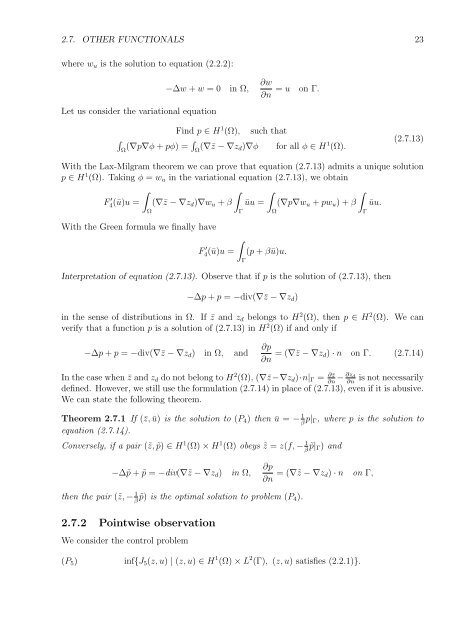Optimal Control of Partial Differential Equations
Optimal Control of Partial Differential Equations
Optimal Control of Partial Differential Equations
You also want an ePaper? Increase the reach of your titles
YUMPU automatically turns print PDFs into web optimized ePapers that Google loves.
2.7. OTHER FUNCTIONALS 23<br />
where wu is the solution to equation (2.2.2):<br />
−∆w + w = 0 in Ω,<br />
Let us consider the variational equation<br />
<br />
Ω<br />
∂w<br />
∂n<br />
= u on Γ.<br />
Find p ∈ H1 (Ω), such that<br />
<br />
(∇p∇φ + pφ) = Ω (∇¯z − ∇zd)∇φ for all φ ∈ H1 (Ω).<br />
(2.7.13)<br />
With the Lax-Milgram theorem we can prove that equation (2.7.13) admits a unique solution<br />
p ∈ H1 (Ω). Taking φ = wu in the variational equation (2.7.13), we obtain<br />
F ′ <br />
<br />
<br />
4(ū)u = (∇¯z − ∇zd)∇wu + β ūu = (∇p∇wu + pwu) + β ūu.<br />
Ω<br />
Γ Ω<br />
Γ<br />
With the Green formula we finally have<br />
F ′ <br />
4(ū)u = (p + βū)u.<br />
Interpretation <strong>of</strong> equation (2.7.13). Observe that if p is the solution <strong>of</strong> (2.7.13), then<br />
Γ<br />
−∆p + p = −div(∇¯z − ∇zd)<br />
in the sense <strong>of</strong> distributions in Ω. If ¯z and zd belongs to H 2 (Ω), then p ∈ H 2 (Ω). We can<br />
verify that a function p is a solution <strong>of</strong> (2.7.13) in H 2 (Ω) if and only if<br />
−∆p + p = −div(∇¯z − ∇zd) in Ω, and<br />
∂p<br />
∂n = (∇¯z − ∇zd) · n on Γ. (2.7.14)<br />
In the case when ¯z and zd do not belong to H2 (Ω), (∇¯z−∇zd)·n|Γ = ∂¯z ∂zd − is not necessarily<br />
∂n ∂n<br />
defined. However, we still use the formulation (2.7.14) in place <strong>of</strong> (2.7.13), even if it is abusive.<br />
We can state the following theorem.<br />
Theorem 2.7.1 If (¯z, ū) is the solution to (P4) then ū = − 1<br />
β p|Γ, where p is the solution to<br />
equation (2.7.14).<br />
Conversely, if a pair (˜z, ˜p) ∈ H 1 (Ω) × H 1 (Ω) obeys ˜z = z(f, − 1<br />
β ˜p|Γ) and<br />
−∆˜p + ˜p = −div(∇˜z − ∇zd) in Ω,<br />
then the pair (˜z, − 1 ˜p) is the optimal solution to problem (P4).<br />
β<br />
2.7.2 Pointwise observation<br />
We consider the control problem<br />
∂p<br />
∂n = (∇˜z − ∇zd) · n on Γ,<br />
(P5) inf{J5(z, u) | (z, u) ∈ H 1 (Ω) × L 2 (Γ), (z, u) satisfies (2.2.1)}.

















